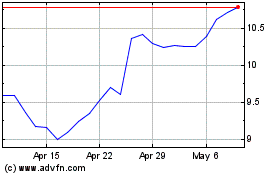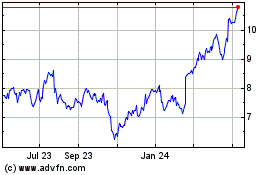Most European Banks Survive Stress Test
July 29 2016 - 5:10PM
Dow Jones News
European regulators gave most of their banks a clean bill of
health Friday, with only a clutch of lenders struggling to ride out
an economic meltdown.
The European Banking Authority presented results of a test
showing how much capital banks would have left on their balance
sheets after a severe downturn.
At the bottom of the pack of 51 banks sat Italy's Banca Monte
dei Paschi di Siena Spa, confirming that the bank needs to raise
substantial fresh funds. Other major banks that were hard hit by
the test included, UniCredit SpA, Barclays PLC and Deutsche Bank
AG.
The stress-test outcomes didn't include a black-and-white result
for each bank, however. That is because unlike previous European
stress tests, the banks didn't have to meet a specific capital
hurdle to pass the exam. With no set, pass or fail criteria, the
EBA left it up to investors and regulators to interpret the
results.
Broadly, investors were looking for banks to maintain at least
5.5% ratio of top-quality capital on their balance sheets after the
hypothetical economic crash was applied, analysts said.
Monte dei Paschi's capital buffer was totally wiped out by the
scenario in the test. The bank had a minus 2.44% ratio of top
quality capital to total risk-adjusted assets when the economic
shock was applied. Ireland's Allied Irish Banks also came in under
the 5.5% bar with capital ratio of 4.3%. All the other banks came
in at over the 5.5% hurdle.
Of the "systemically important" European banks, Italy's
UniCredit fared the worst with a ratio of 7.1%. The bank is likely
to raise capital later this year, according to a person familiar
with the matter. Barclays, had a capital ratio of 7.3%. Deutsche
Bank AG, whose capital levels are being closely scrutinized, had a
7.8% capital level.
Regulators will use the numbers to calculate each bank's capital
requirement later in the year. Underperforming banks could be
guided to hold more capital by regulators, but authorities are
unlikely to force wide-scale recapitalizations. Alternatively,
banks could face tougher "qualitative measures" such as improving
risk controls.
The European Central Bank and the Bank of England have in the
past said that their banking systems have enough capital. In total
the banks in the test raised €180 billion ($199 billion) of capital
between the end of 2013 and the end of 2015. The issue now is how
to clear a mound of bad loans festering on bank balance sheets.
This year's stress tests didn't include struggling Greek and
Portuguese banks. Smaller lenders are being privately tested by
regulators and the results won't be made public.
Write to Max Colchester at max.colchester@wsj.com and Jenny
Strasburg at jenny.strasburg@wsj.com
(END) Dow Jones Newswires
July 29, 2016 16:55 ET (20:55 GMT)
Copyright (c) 2016 Dow Jones & Company, Inc.
Barclays (NYSE:BCS)
Historical Stock Chart
From Mar 2024 to Apr 2024

Barclays (NYSE:BCS)
Historical Stock Chart
From Apr 2023 to Apr 2024
